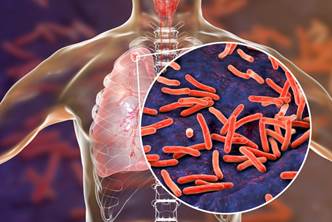Description

Disclaimer: Copyright infringement not intended.
Context
- Only two-thirds of people living with tuberculosis benefitted from the Union government’s sole nutrition support scheme - Nikshay Poshan Yojana, highlighting bottlenecks in the fight against a major public health concern.
About Tuberculosis (TB)
- Tuberculosis (TB) is a potentially serious infectious disease that mainly affects the lungs.
- The ‘Mycobacterium tuberculosis’ bacteria that cause TB are spread when an infected person coughs or sneezes.
- Most people infected with the bacteria that cause tuberculosis don't have symptoms. When symptoms do occur, they usually include a cough (sometimes blood-tinged), weight loss, night sweats and fever.
- Treatment isn't always required for those without symptoms. Patients with active symptoms will require a long course of treatment involving multiple antibiotics.
Present Status of TB in India
- Tuberculosis is one of India's major public health problems. According to World Health Organisation (WHO) estimates, India has the world's largest tuberculosis epidemic.
- In 2020, India accounted for 26% of the incident TB cases across the globe.
- India has an incidence rate of 192 cases per 100,000 of population.
- India accounted for 38% of global TB deaths among HIV-negative people and for 34% of the combined total number of TB deaths in HIV-negative and HIV-positive people.
- Further in 2020, India accounted for 24% of the global gap between estimated TB incidence and the number of people newly diagnosed with TB and reported.
Steps taken by the Government
- In 2020, the Indian government made statements to eliminate tuberculosisfrom the country by 2025 through its National TB Elimination Program.
- Interventions in this program include major investment in health care.
- Providing supplemental nutrition credit through the Nikshay Poshan Yojana.
- Organizing a national epidemiological survey for tuberculosis.
- Organizing a national campaign to tie together the Indian government and private health infrastructure for the goal of eliminating the disease.
- The ministry's commitment to eliminating tuberculosis in the country by 2025.
- As part of its efforts to eliminate tuberculosis, the Union Government changed the name of Revised National Tuberculosis Control Program (RNTCP) to National Tuberculosis Elimination Program (NTEP) in December 2019.
Details of Nikshay Poshan Yojana
- The Nikshay Poshan Yojana entitles every tuberculosis (TB) patient, seeking treatment in either the public or private sector, to a direct benefit transfer (DBT) of Rs 500 per month for nutritional needs. It was launched in April 2018 and until February 2022, around Rs 1,488 crore has been paid to 5.73 million notified beneficiaries.
- However, data from the latest India TB Report 2022, released by the Union Ministry of Health and Family Welfare in March 2022, shows that only 62.1 per cent of 2.1 million notified cases across the country received at least one payment in 2021.
- In Delhi, which has the highest burden of all forms of TB at 747 cases per 100,000 people, only 30.2 per cent of patients have got at least one DBT.
- Other poor performers are Punjab (31.8 per cent), Jharkhand (40.1 per cent), Maharashtra (46.6 per cent), Bihar (45.8 per cent), Rajasthan (55.9 per cent) and Uttar Pradesh (58.7 per cent). In the North East, Manipur (4.2 per cent) and Meghalaya (23.7 per cent) fared the worst.
Challenges in implementing the Scheme
- Studies on the scheme since its inception highlight several hurdles in the DBT process. One 2018 paper in the Indian Journal of Tuberculosis, found that “non-availability of bank accounts and unlinked bank accounts were some challenges faced by both health providers and patients.”
- Another 2020 study published in the Journal of Family Medicine and Primary Care underlines lack of communication, stigma, illiteracy and the multi-step approval process as key hurdles.
- States have their own nutritional support schemes, but caveats remain here too; for instance, some schemes are only for patients showing resistance to TB drugs.

Concern
- India has set a target to eliminate TB by 2025. Experts believe that to reach this goal, the country must go beyond the medical aspects.
- Undernutrition is a major risk factor that drives TB, acknowledges the World Health Organization. The condition accounts for nearly 34 per cent of all cases.
Final thoughts
- The government needs to take stock of where the bottlenecks are. There is no point in pouring more money into a failing system.
- Any investment in diagnostic treatments is irrelevant if people fighting TB are living on an empty stomach. It affects the poorest populations and almost every family is in financial distress due to medical costs and lost wages.
- This distress can worsen food insecurity. A broader approach is needed to prevent TB, and it should include food support for those in close contact with the patient as they are also at high risk of contracting the disease.
https://www.downtoearth.org.in/news/health/tb-nutrition-aid-falls-short-84502
















